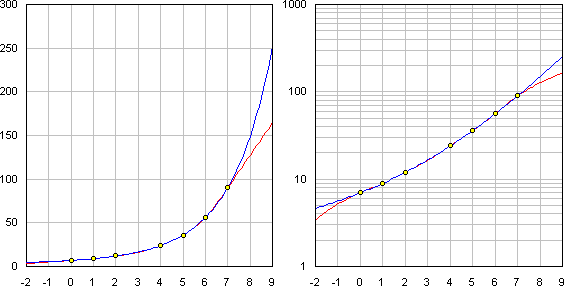LAST EDITED ON Sep-21-03 AT 10:31 PM (EST)
How do you figure a solution to this kind of thing? What does the article suggest? Anything I try now looks like playing smart after the fact.7 = 7
9 = 3·3
12 = 3·2·2
???
24 = 2·2·2·3
36 = 2·2·3·3
56 = 2·2·2·7
90 = 2·3·3·5
Note that multiplying the 4 numbers below the unknown number by 1, 2, 3, 4 makes all of them multiples of 3 and 8:
24·1 = 2·2·2·3
36·2 = 2·2·2·3·3
56·3 = 2·2·2·3·7
90·4 = 2·2·2·3·3·5
24·1 = 24·1
36·2 = 24·3
56·3 = 24·7
90·4 = 24·15
Numbers 1, 3, 7, 15 have the suspicious look of powers of 2 decreased by 1
24·1 = 24·(2 - 1)
36·2 = 24·(4 - 1)
56·3 = 24·(8 - 1)
90·4 = 24·(16 - 1)
24 = 24·(2 - 1)/1
36 = 24·(4 - 1)/2
56 = 24·(8 - 1)/3
90 = 24·(16 - 1)/4
Does the pattern hold for the numbers above the unknown number?
12 = 24·(1/2 - 1)/(-1)
9 = 24·(1/4 - 1)/(-2)
7 = 24·(1/8 - 1)/(-3)
Yes it does.
an = 24·(2n-3 - 1)/(n - 3), n ¹ 3
Extend the range of function an to real numbers x ¹ 3 and calculate the limit for x ® 3 using the l'Hospital rule
a(x) = 24·(2x-3 - 1)/(x - 3)
lim a(x) = 24·lim{(2x-3 - 1)/(x - 3)} = 24·lim {(2x-3 - 1)} / lim (x - 3) =
= 24·lim {ln(2)·2x-3} / lim 1 = 24·ln(2) » 16.6355
If I really needed the missing number, I would go about it differently. First, I would plot the sequence in Excel. This is not playing smart after the fact, I did that for the bizarre sequence 1, 2, 4, 8, 16, 31, 37, 43, 67, ... as well. Our sequence 7, 9, 12, ?, 24, 36, 56, 90 looks like a smooth function of natural numbers and I would interpolate using a natural spline.
Splines (particulary natural splines) are very useful and for those not familiar with splines I present a few details. A spline Sm(x) of the m-th order with connection points x1 < x2 < ... < xn is a function given in each interval (-¥, x1), (x1, x2), ..., (xn, ¥) by a polynomial of at most m-th degree and the derivatives of Sm are continuous up to the (m - 1)-th order. A spline of the m-th order can be expressed as
Sm(x) = Pm(x) + Sni=1 ci(x - xi)+m
where Pm(x) is a polynomial of at most m-th degree and the ()+ operator means "the positive part of". For a given table f(x1), f(x2), ..., f(xn) of function values, the general spline is not unique, which is unpleasant. Uniqueness is guaranteed for natural splines. A natural spline of the (2k + 1)-th order (only odd order natural splines do exist) is a spline that can be expressed as
N2k+1(x) = Pk(x) + Sni=1 ci(x - xi)+2k+1
where Pk(x) is a polynomial of at most k-th degree. To get the k + 1 coefficients of the polynomial Pk(x) and the n coefficients c1, c2, ... cn for a given table f(x1), f(x2), ..., f(xn) of function values, we have n linear equations
N2k+1(xi) = f(xi), i = 1, 2, ..., n
and k + 1 linear equations
Sni=1 cip = 0, p = 0, 1, ..., k
The last k + 1 equations result from limiting the dergee of the polynomial P2k+1(x) for a general odd order spline to the polynomial Pk(x) for the natural spline.
A natural spline of the first order for a given table of function values is a piecewise linear function inside the table that turns to constants outside the table. Which is the "natural" thing to do. Natural splines of higher orders are a generalization of this concept. Since a spline is a piecewise polynomial function, its integral can be calculated directly. Starting with the 3-rd order, splines have continuous first and second derivatives, which means that common methods of successive approximations can be used to find their roots and extrema.
To find the natural spline of the 3-rd order for the sequence 7, 9, 12, ?, 24, 36, 56, 90 we form a 9´9 matrix (n = 7, k = 1, n + k + 1 = 9) for the above 9 linear equations:
½ 0 0 0 0 0 0 0 1 0½ ½c1½ ½ 7½
½ 1 0 0 0 0 0 0 1 1½ ½c2½ ½ 9½
½ 8 1 0 0 0 0 0 1 2½ ½c3½ ½12½
½ 64 27 8 0 0 0 0 1 4½ ½c4½ ½24½
½ 125 64 27 1 0 0 0 1 5½ ½c5½ = ½36½
½ 216 125 64 8 1 0 0 1 6½ ½c6½ ½56½
½ 343 216 125 27 8 1 0 1 7½ ½c7½ ½90½
½ 1 1 1 1 1 1 1 0 0½ ½a0½ ½ 0½
½ 0 1 2 4 5 6 7 0 0½ ½a1½ ½ 0½
Calculating the inverse matrix (using the Excel MINVERSE array function) and multiplying it by the right side column, we get the 7 coeeficients c1, c2, ..., c7 of the 3-rd order natural spline N3(x) and the 2 coefficients a0, a1 of the polynomial P1(x). Calculating the value of the natural spline for x = 3:
N3(3) » 16.5363
which is pretty close to 24·ln(2) » 16.6355 (0.60% less). Using a natural spline of the 5-th order would yield a slightly better result - 16.5684 (0.40% less than 24·ln(2)). The plots show how well a 3-rd order natural spline approximates a smooth function given by a table of a few function values inside the table.

Blue lines represent the function a(x) = 24·(2x-3 - 1)/(x - 3) and the red lines the 3-rd order natural spline N3(x) through the 7 given points.
Regards, Vladimir